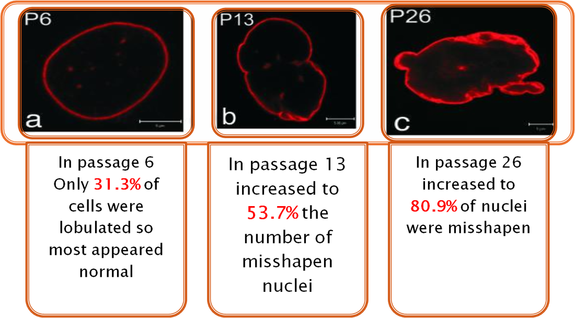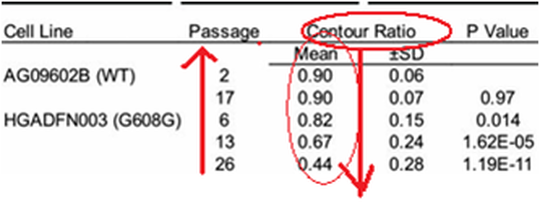Published by:
By PNAS (Proceedings of National Academy of Sciences of the United States of America) on June 7, 2004
By PNAS (Proceedings of National Academy of Sciences of the United States of America) on June 7, 2004
Full Version available: : http://www.pnas.org/content/101/24/8963.full
Summarized by the author of this website below:
Purpose
To examine the nuclear structural changes caused by LMNA mutation in normal cells and cells from Progerian ( HGPS) patients.
2 Parts to the experiment:
PART 1
Procedure: They studied the nucleus over time of Progeria cells and normal cells. In the experiment they determined the overall percentage of lobulated or misshapen nuclei in cells at different passage numbers (amount of times cells have been cultured). Two hundred randomly selected nuclei were labeled lobulated and non-lobulated.
Results:
PART 1
Procedure: They studied the nucleus over time of Progeria cells and normal cells. In the experiment they determined the overall percentage of lobulated or misshapen nuclei in cells at different passage numbers (amount of times cells have been cultured). Two hundred randomly selected nuclei were labeled lobulated and non-lobulated.
Results:
**They found that in normal cells which were the control lobulation on the nuclei also appeared, but they never appeared as severely misshapen as in HGPS cells .
PART 2
Procedure:In part 2 they studied the nucleus over time of progeria cells and normal cells. Instead of determining the percent of lobulated nuclei they calculated the nuclear roundness or contour ratio. Contour Ratio is determined by 4∏ x area/perimeter. Contour Ratio of a circle is 1 and as the nucleus becomes more lobulated the ratio approaches zero.
Results of Part 2:
Procedure:In part 2 they studied the nucleus over time of progeria cells and normal cells. Instead of determining the percent of lobulated nuclei they calculated the nuclear roundness or contour ratio. Contour Ratio is determined by 4∏ x area/perimeter. Contour Ratio of a circle is 1 and as the nucleus becomes more lobulated the ratio approaches zero.
Results of Part 2:
Summary of Results: They found that the greater the passage the more the nucleus were lobulated. In the control there were no great changes in the contour ratio.
CONCLUSION of the 2004 Experiment:
1) There are PROGRESSIVE alterations in the nuclear shape in cells of Progerian patients.
2) In normal cells the majority of the nuclear cells appeared normal after many passages.
2) In normal cells the majority of the nuclear cells appeared normal after many passages.


